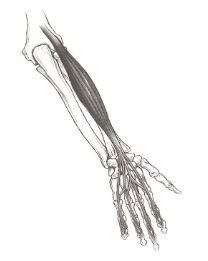ANATOMY TEST #3 Reviw
5.0(1)
5.0(1)
Card Sorting
1/46
Earn XP
Description and Tags
This is only on the muscles that we learned, NOT about any bony landmarks. ALSO for the erector spinae muscles, I am not completely sure about the origin or insertions!
Study Analytics
Name | Mastery | Learn | Test | Matching | Spaced | Call with Kai |
|---|
No study sessions yet.
47 Terms
1
New cards
Sternocleidomastoid(SCM)
**Origin**: Anterior and superior manubrium & superior medial 1/3 of clavicle
**Insertion**: Lateral aspect of mastoid process & anterior 1/2 of superior nuchal line
**Action**:
Unilaterally: laterally flexes head and neck to same side, rotates head to opposite side
Bilaterally flexes neck & assists in inhalation
**Insertion**: Lateral aspect of mastoid process & anterior 1/2 of superior nuchal line
**Action**:
Unilaterally: laterally flexes head and neck to same side, rotates head to opposite side
Bilaterally flexes neck & assists in inhalation
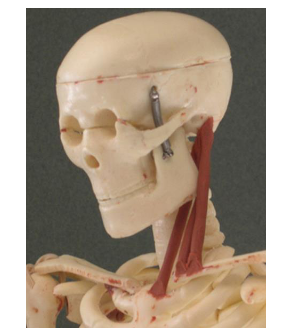
2
New cards
Anterior Scalenes
**Origin**: C3-C6 transverse processes
**Insertion**: 1st rib
**Action**:
Unilaterally flexes head to same side when rib is fixed, rotates head to opposite side
Bilaterally elevates ribs during inhalation & flexes head and neck
**Insertion**: 1st rib
**Action**:
Unilaterally flexes head to same side when rib is fixed, rotates head to opposite side
Bilaterally elevates ribs during inhalation & flexes head and neck
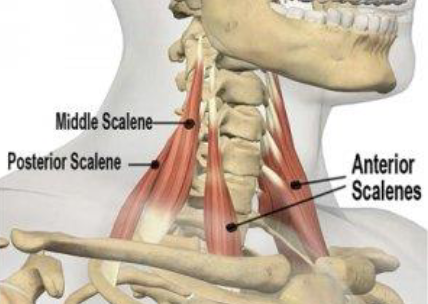
3
New cards
Middle Scalenes
**Origin**:C2-C7 transverse processes
**Insertion**: 1st rib
**Action**:
Unilaterally flexes head same side when rib is fixed, rotates head to opposite side
Bilaterally elevates ribs during inhalation
**Insertion**: 1st rib
**Action**:
Unilaterally flexes head same side when rib is fixed, rotates head to opposite side
Bilaterally elevates ribs during inhalation
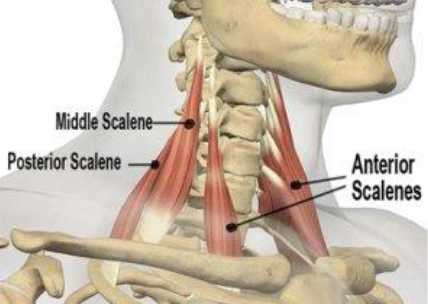
4
New cards
Posterior Scalenes
**Origin**: C4-C6 transverse processes
**Insertion**: 2nd rib
**Action**:
Unilaterally flexes head to same side when rib is fixed, rotates head to opposite side
Bilaterally elevates ribs during inhalation
**Insertion**: 2nd rib
**Action**:
Unilaterally flexes head to same side when rib is fixed, rotates head to opposite side
Bilaterally elevates ribs during inhalation
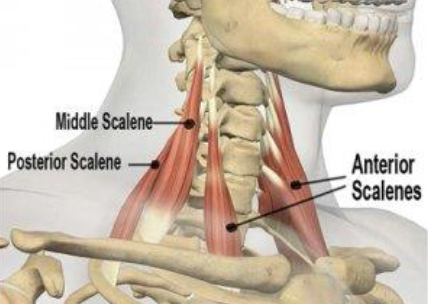
5
New cards
Spinalis
It arises from the common origin and extends from the spinous processes in the superior lumbar and inferior thoracic regions to the spinous processes in the superior thoracic region
**Action**:
Unilaterally: laterally flexes head or the vertebral column
Bilaterally: extend head and part or all of the vertebral column
**Action**:
Unilaterally: laterally flexes head or the vertebral column
Bilaterally: extend head and part or all of the vertebral column
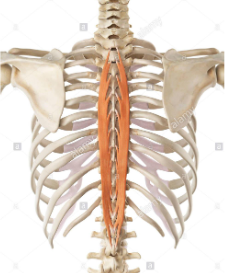
6
New cards
Longissimus
arises from the common origin and is attached to the transverse processes of the thoracic and cervical vertebrae, and the mastoid process of the temporal bone of the skull.
**Action**:
Unilaterally: laterally flexes head or the vertebral column, rotates head to the same side
Bilaterally: extend head and part or all of the vertebral column
**Action**:
Unilaterally: laterally flexes head or the vertebral column, rotates head to the same side
Bilaterally: extend head and part or all of the vertebral column
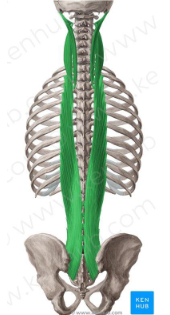
7
New cards
Iliocostalis
arises fromthe common origin and inserts into the angles of the ribs.
**Action**:
Unilaterally: laterally flexes head or the vertebral column
Bilaterally: extend head and part or all of the vertebral column
**Action**:
Unilaterally: laterally flexes head or the vertebral column
Bilaterally: extend head and part or all of the vertebral column
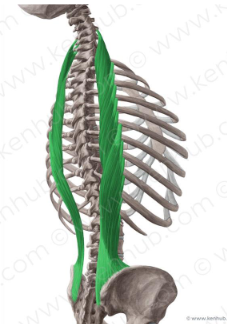
8
New cards
Multifidus
**Origin**: Transverse process of one vertebrae
**Insertion**: Spinous processes of all vertebrae extending from 2-4 vertebrae higher
**Action**:
Unilaterally rotates vertebral bodies(column) to opposite side and lateral flexion to same side
Bilaterally extends vertebral column
**Insertion**: Spinous processes of all vertebrae extending from 2-4 vertebrae higher
**Action**:
Unilaterally rotates vertebral bodies(column) to opposite side and lateral flexion to same side
Bilaterally extends vertebral column
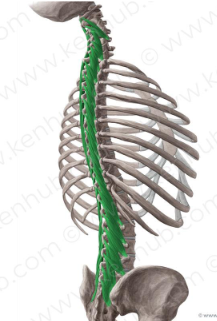
9
New cards
Rotatores
**Origin**: Transverse process of one vertebra
**Insertion**: Spinous process of vertebra 1-2 above
**Action**:
Unilaterally rotate vertebral body to opposite side
Bilaterally extends vertebral column
**Insertion**: Spinous process of vertebra 1-2 above
**Action**:
Unilaterally rotate vertebral body to opposite side
Bilaterally extends vertebral column
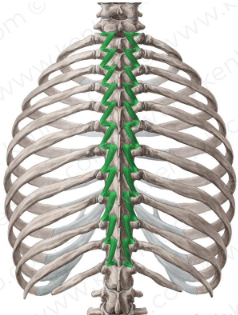
10
New cards
Rectus Abdominus
**Origin**: Pubis crest, Pubic symphysis
**Insertion**: Ribs(5-6) & Xiphoid Process
**Action**: Trunk flexion with resistance, accessory respiratory muscle
**Insertion**: Ribs(5-6) & Xiphoid Process
**Action**: Trunk flexion with resistance, accessory respiratory muscle
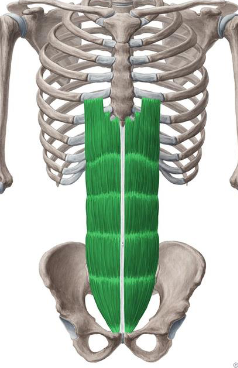
11
New cards
Internal Obliques
**Origin**: Inguinal ligament, iliac crest, thoracolumbar fascia
**Insertion**: Inferior three or four costal cartilages, linea alba, conjoined tendon to pubis
**Action**:
Unilaterally: laterally flexes vertebral column to same side, rotates trunk to same side
Bilaterally: flexes the vertebral column & compresses abdominal content
**Insertion**: Inferior three or four costal cartilages, linea alba, conjoined tendon to pubis
**Action**:
Unilaterally: laterally flexes vertebral column to same side, rotates trunk to same side
Bilaterally: flexes the vertebral column & compresses abdominal content

12
New cards
External Obliques
**Origin**: lower 8 ribs at costal cartilages
**Insertion**: crest of ilium, linea alba through rectus sheath
**Action**:
Unilaterally: laterally flexes vertebral column to same side, rotates vertebral column to opposite side
Bilaterally: flexes the vertebral column & compresses abdominal contents
**Insertion**: crest of ilium, linea alba through rectus sheath
**Action**:
Unilaterally: laterally flexes vertebral column to same side, rotates vertebral column to opposite side
Bilaterally: flexes the vertebral column & compresses abdominal contents

13
New cards
Transverse Abdominus
**Origin**: Cartilages of six lower ribs, throacolumbar fascia, iliac crest, inguinal ligament
**Insertion**: linea alba through rectus sheath, conjoined tendon to pubis
**Action**: compresses abdominal viscera
**Insertion**: linea alba through rectus sheath, conjoined tendon to pubis
**Action**: compresses abdominal viscera
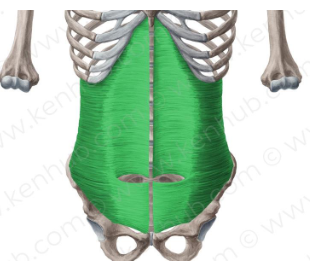
14
New cards
Diaphragm
**Action**: breathing
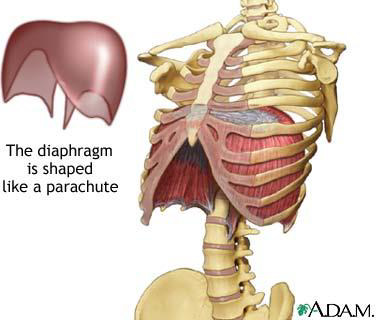
15
New cards
Pectoralis Major
**Origin**: medial 1/2 of clavicle, sternum, & cartilage of ribs 1-6
**Insertion**: crest of greater tubercle of humerus
**Action**: adducts, horizontally flexes, flexes, and rotates arm medially
**Insertion**: crest of greater tubercle of humerus
**Action**: adducts, horizontally flexes, flexes, and rotates arm medially
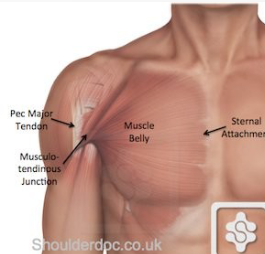
16
New cards
Pectoralis Minor
**Origin**: ribs 3-5
**Insertion**: coracoid process of scapula
**Action**: depresses scapula abducts scapula, tilts scapula anteriorly, assists in forced inhalation
**Insertion**: coracoid process of scapula
**Action**: depresses scapula abducts scapula, tilts scapula anteriorly, assists in forced inhalation
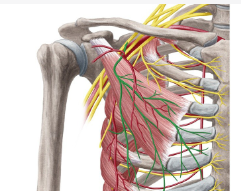
17
New cards
Serratus Anterior
**Origin**: ribs 1-8 or 9
**Insertion**: anterior surface of medial border of scapula
**Action**: draws scapula forward, rotates scapula to raise shoulder in abduction of arm, scapular abduction against resistance
**Insertion**: anterior surface of medial border of scapula
**Action**: draws scapula forward, rotates scapula to raise shoulder in abduction of arm, scapular abduction against resistance
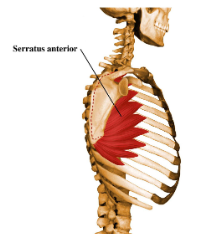
18
New cards
Trapezius
**Origin**: occipital bone, nuchal ligament, spinous processes of C7-T12
**Insertion**: lateral 1/3 of clavicle, acromion, and spine of scapula
**Action**:
__Upper fibers:__
Unilaterally: laterally flexes head/neck to same side, rotates head to opposite side, elevates and upwardly rotates scapula
Bilaterally extends head and neck
__Middle fibers:__ adducts and stabilizes scapula
__Lower fibers:__ depresses scapula and upwardly rotates scapula
**Insertion**: lateral 1/3 of clavicle, acromion, and spine of scapula
**Action**:
__Upper fibers:__
Unilaterally: laterally flexes head/neck to same side, rotates head to opposite side, elevates and upwardly rotates scapula
Bilaterally extends head and neck
__Middle fibers:__ adducts and stabilizes scapula
__Lower fibers:__ depresses scapula and upwardly rotates scapula
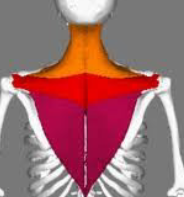
19
New cards
Rhomboid Major
**Origin**: spinous processes of T2-5
**Insertion**: medial margin of scapula between spine and inferior angle
**Action**: retracts, elevates scapula, & downwardly rotates scapula
**Insertion**: medial margin of scapula between spine and inferior angle
**Action**: retracts, elevates scapula, & downwardly rotates scapula
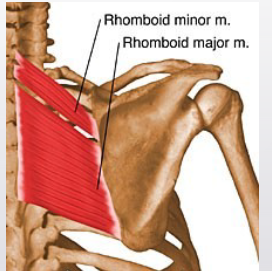
20
New cards
Rhomboid Minor
**Origin**: spinous processes of C7-T1, lower part of nuchal ligament
**Insertion**: medial margin of scapula at root of the spine
**Action**: adducts, elevates, & downwardly rotates scapula
**Insertion**: medial margin of scapula at root of the spine
**Action**: adducts, elevates, & downwardly rotates scapula
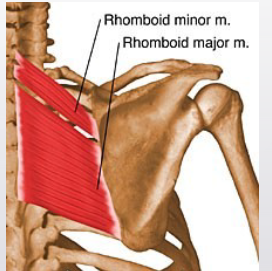
21
New cards
Levator Scapulae
**Origin**: transverse processes of C1-C4
**Insertion**: superior angle of scapula
**Action**:
Unilaterally elevates, downwardly rotates scapula, laterally flexes head/neck & rotates head to same side
Bilaterally extends neck and head
**Insertion**: superior angle of scapula
**Action**:
Unilaterally elevates, downwardly rotates scapula, laterally flexes head/neck & rotates head to same side
Bilaterally extends neck and head
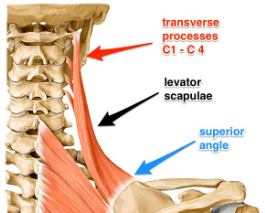
22
New cards
Latissimus Dorsi
**Origin**: T6-T12, last 3-4 ribs, posterior iliac crest, & thorocolumnar aponeurosis
**Insertion**: intertubercle groove & crest of lesser tubercle of humerus
**Action**: extension, adduction, internal rotation
**Insertion**: intertubercle groove & crest of lesser tubercle of humerus
**Action**: extension, adduction, internal rotation
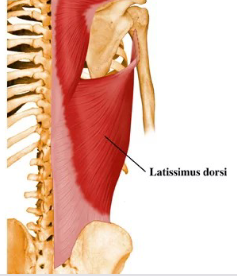
23
New cards
Supraspinatus
**Origin**: supraspinous fossa
**Insertion**: greater tuberosity
**Action**: abducts shoulder to about 45 degrees, stabilize head of humerus in glenoid cavity
**Insertion**: greater tuberosity
**Action**: abducts shoulder to about 45 degrees, stabilize head of humerus in glenoid cavity
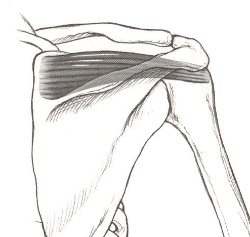
24
New cards
Infraspinatus
**Origin**: infraspinous fossa
**Insertion**: greater tuberosity
**Action**: laterally rotates, adducts, extends, horizontally abducts shoulder, and stabilizes head of humerus in glenoid fossa
**Insertion**: greater tuberosity
**Action**: laterally rotates, adducts, extends, horizontally abducts shoulder, and stabilizes head of humerus in glenoid fossa
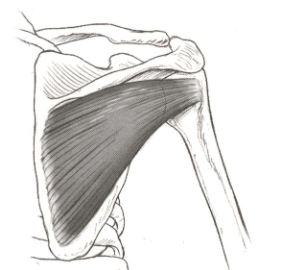
25
New cards
Teres Minor
**Origin**: superior lateral border
**Insertion**: greater tuberosity
**Action**: laterally rotates, adducts, extends, horizontally abducts shoulder, and stabilizes head of humerus in glenoid fossa
**Insertion**: greater tuberosity
**Action**: laterally rotates, adducts, extends, horizontally abducts shoulder, and stabilizes head of humerus in glenoid fossa
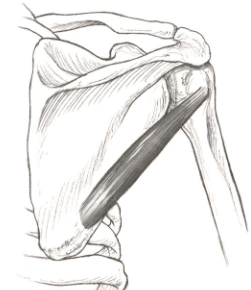
26
New cards
Subscapularis
**Origin**: subscapular fossa
**Insertion**: lesser tuberosity
**Action**: internal rotation, stabilizes head of humerus in glenoid fossa
**Insertion**: lesser tuberosity
**Action**: internal rotation, stabilizes head of humerus in glenoid fossa
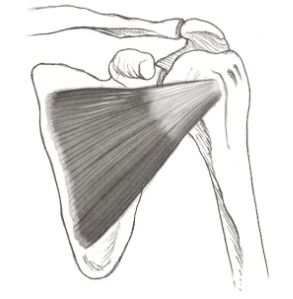
27
New cards
Anterior Deltoid
**Origin**: lateral 1/3 of clavicle
**Insertion**: deltoid tuberosity
**Action**: shoulder flexion, medial rotation, horizontal adduction
**Insertion**: deltoid tuberosity
**Action**: shoulder flexion, medial rotation, horizontal adduction
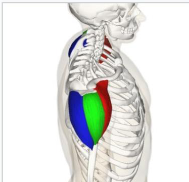
28
New cards
Middle Deltoid
**Origin**: border of acromion
**Insertion**: deltoid tuberosity
**Action**: shoulder abduction
**Insertion**: deltoid tuberosity
**Action**: shoulder abduction
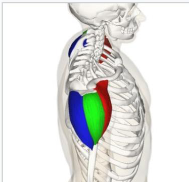
29
New cards
Posterior Deltoid
**Origin**: scapular spine
**Insertion**: deltoid tuberosity
**Action**: shoulder extension, lateral rotation, horizontal abduction
**Insertion**: deltoid tuberosity
**Action**: shoulder extension, lateral rotation, horizontal abduction
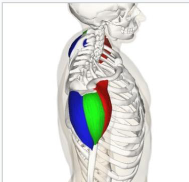
30
New cards
Teres Major
**Origin**: inferior angle of scapula & lower 1/2 of lateral border of scapula
**Insertion**: intertubercle groove
**Action:** adduction, internal rotation, shoulder extension
**Insertion**: intertubercle groove
**Action:** adduction, internal rotation, shoulder extension
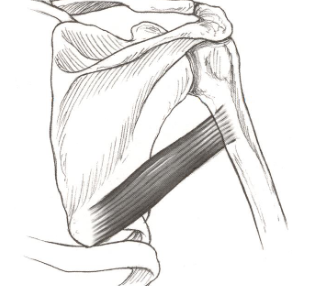
31
New cards
Biceps Brachii
**Origin:**
__Long Head:__ supraglenoid tubercle of scapula
__Short Head__: coracoid process
**Insertion:** radial tuberosity
Action: elbow flexion in hand in supination, shoulder flexion, synergist in supination of forearm
__Long Head:__ supraglenoid tubercle of scapula
__Short Head__: coracoid process
**Insertion:** radial tuberosity
Action: elbow flexion in hand in supination, shoulder flexion, synergist in supination of forearm
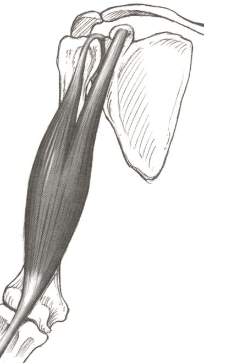
32
New cards
Brachialis
**Origin**: lower 1/2 of humerus
**Insertion**: coranoid process of ulna
**Action**: elbow flexion with hand in pronation
**Insertion**: coranoid process of ulna
**Action**: elbow flexion with hand in pronation
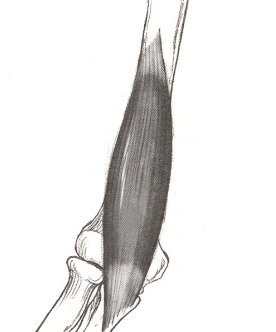
33
New cards
Brachioradialis
**Origin**: lateral supracondylar ridge of humerus
**Insertion**: radial styloid process
**Action**: elbow flexion with hand in neutral position
**Insertion**: radial styloid process
**Action**: elbow flexion with hand in neutral position
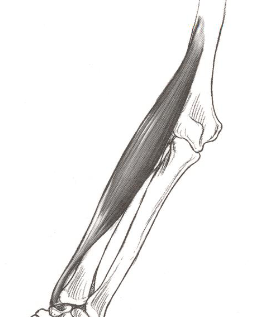
34
New cards
Coracobrachialis
**Origin**: coracoid process of scapula
**Insertion**: medial surface of shaft of humerus
**Action**: shoulder flexion, shoulder adduction
**Insertion**: medial surface of shaft of humerus
**Action**: shoulder flexion, shoulder adduction
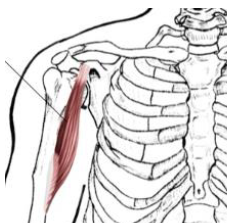
35
New cards
Triceps Brachii
**Origin**:
__Long head__: infraglenoid tubercle of scapula
__Medial head__: lower 1/2 of posterior humerus
__Lateral head__: upper 1/2 of humerus
**Insertion**: olecranon process
**Actions**: all heads extend elbow; __long head__ extends and adducts shoulder
__Long head__: infraglenoid tubercle of scapula
__Medial head__: lower 1/2 of posterior humerus
__Lateral head__: upper 1/2 of humerus
**Insertion**: olecranon process
**Actions**: all heads extend elbow; __long head__ extends and adducts shoulder
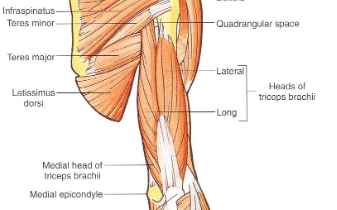
36
New cards
Anconeus
**Origin**: lateral epicondyle of humerus
**Insertion**: lateral surface of olecranon & superior part of posterior ulnar surface
**Action**: help triceps in extending forearm, stabilizes elbow joint
**Insertion**: lateral surface of olecranon & superior part of posterior ulnar surface
**Action**: help triceps in extending forearm, stabilizes elbow joint
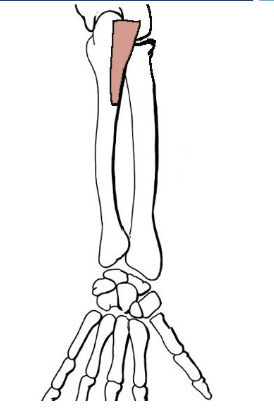
37
New cards
Flexor Carpi Radialis
**Origin**: medial epicondyle of humerus
**Insertion**: base of 2nd and 3rd metacarpals
**Action**: wrist flexion, radial deviation
**Insertion**: base of 2nd and 3rd metacarpals
**Action**: wrist flexion, radial deviation
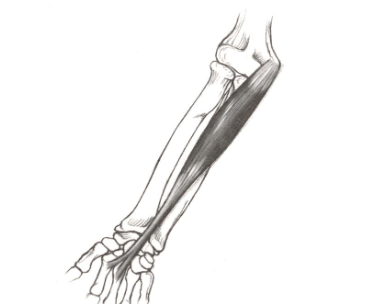
38
New cards
Flexor Carpi Ulnaris
**Origin**: medial epicondyle of humerus
**Insertion**: base of 5th metacarpal
**Action**: wrist flexion, ulnar deviation
**Insertion**: base of 5th metacarpal
**Action**: wrist flexion, ulnar deviation

39
New cards
Palmaris Longus
**Origin**: medial epicondyle of humerus
**Insertion**: palmar aponeurosis
**Action**: wrist flexion
**Insertion**: palmar aponeurosis
**Action**: wrist flexion
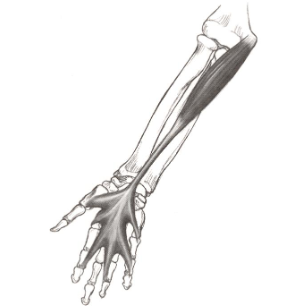
40
New cards
Extensor Carpi Radialis
**Origin**: lateral epicondyle of humerus
**Insertion**: 2nd and 3rd metacarpals
**Actions**: wrist extension, radial deviation
**Insertion**: 2nd and 3rd metacarpals
**Actions**: wrist extension, radial deviation
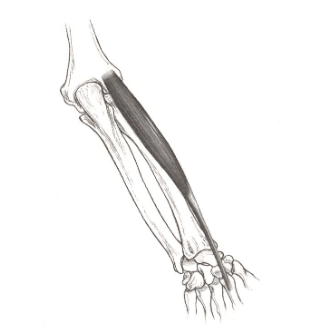
41
New cards
Extensor Carpi Ulnaris
**Origin**: lateral epicondyle of humerus
**Insertion**: base of 5th metacarpal
**Action**: wrist extension, ulnar deviation
**Insertion**: base of 5th metacarpal
**Action**: wrist extension, ulnar deviation
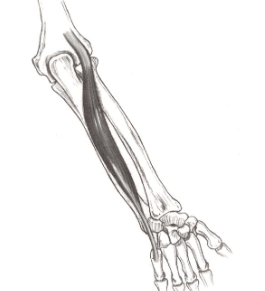
42
New cards
Pronator Teres
**Origin**: distal humerus, proximal ulna
**Insertion**: middle of the lateral surface of the radius
**Action**: pronation, weak elbow flexion
**Insertion**: middle of the lateral surface of the radius
**Action**: pronation, weak elbow flexion
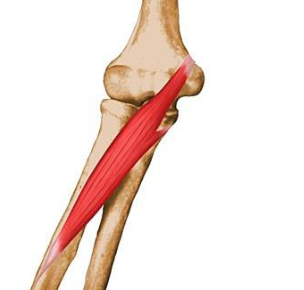
43
New cards
Supinator
**Origin**: lateral humerus, superior to epicondyle
**Insertion**: lateral, posterior, and anterior surface of proximal 1/3 of radius
**Action**: supinates forearm
**Insertion**: lateral, posterior, and anterior surface of proximal 1/3 of radius
**Action**: supinates forearm
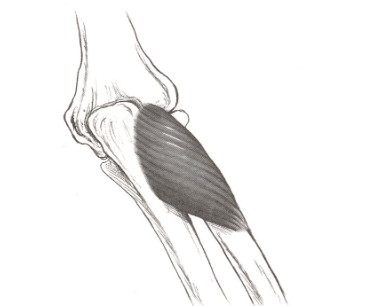
44
New cards
Pronator Quadratus
**Origin**: distal 1/4 of anterior surface of ulna
**Insertion**: distal 1/4 of anterior surface of radius
**Action**: pronates forearm
**Insertion**: distal 1/4 of anterior surface of radius
**Action**: pronates forearm
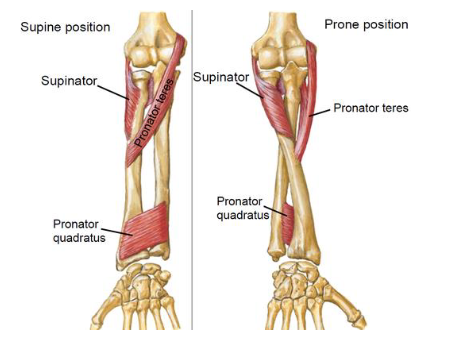
45
New cards
Flexor Digitorum Superficialis
**Origin**: medial epicondyle of humerus
**Insertion**: intermediate phalanx of 2-5
**Action**: flexion of proximal interphalangeal joints
**Insertion**: intermediate phalanx of 2-5
**Action**: flexion of proximal interphalangeal joints
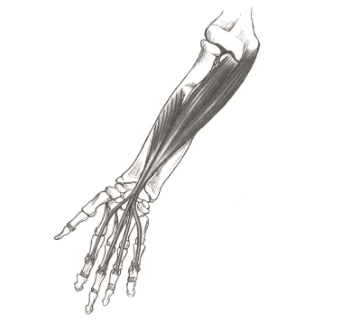
46
New cards
Flexor Digitorum Profundus
**Origin**: shaft of ulna
**Insertion**: distal phalanx of 2-5
**Action**: flexion of distal interphalangeal joints
**Insertion**: distal phalanx of 2-5
**Action**: flexion of distal interphalangeal joints
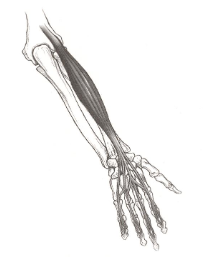
47
New cards
Extensor Digitorum
**Origin**: lateral epicondyle of humerus
**Insertion**: distal and intermediate phalanx of 2-5
**Action**: extension of distal and proximal interphalangeal joints
**Insertion**: distal and intermediate phalanx of 2-5
**Action**: extension of distal and proximal interphalangeal joints
